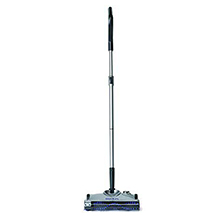Steam cleaner purchasing advice: how to choose the right product
- What you need to know
- Steam cleaners allow you to clean floor and wall surfaces as well as patios.
- Steam cleaners can be also used to freshen up textiles like carpets and fabric sofas.
- They dissolve greasy and oily dirt and remove more than 99 percent of bacteria. They do so without the use of chemical cleaning agents.
- In this article, we will discuss the differences between steam cleaners, steam mops, steam vacuums, and handheld steam cleaners, and explain how window steam cleaners and combination devices work.
- Depending on the task, some devices are better suited than others. Special features or accessories such as extra nozzles can also help with cleaning.
Steam cleaner basics
Steam cleaners are versatile devices that make cleaning surfaces and furniture at home easy and at the same time protect the environment, because they mean you don’t need to use any chemical cleaning agents. With steam cleaners, you can clean, disinfect or degrease hard floors, carpets or fabric sofas and car seats more thoroughly than would be possible with a vacuum cleaner or a simple cloth.
How do they work? Water is heated in a tank by an electric heating element, vaporized into steam and emitted under high pressure through a nozzle. The microscopically small steam molecules penetrate the smallest irregularities of a surface and dissolve greasy, oily and waxy dirt due to their high temperature. This means that hygienic cleaning is possible without the use of chemical cleaning agents.
Steam at the front of the nozzle can be very hot
Always be careful when using a steam cleaning appliance and read the instructions supplied by the manufacturer carefully. Touching the nozzle tip of a switched-on appliance can cause scalds and burns.
Advantages of cleaning with steam
Cleaning with steam has several advantages over conventional cleaning methods. First and foremost, it is extremely effective. The microscopic hot steam particles loosen dirt even in textile fibres that are difficult to reach when cleaning by hand. You may be familiar with the highly visible effect of carpets that are treated with a steam cleaner or steam vacuum for the first time after years of use. The brightening effect is striking, and clearly visible.
No need for chemicals
One of the biggest advantages of steam cleaners is that, according to the manufacturers Kärcher or Leifheit, they kill 99.99 percent of bacteria without using chemical additives. This is a great cost saver, as you do not have to budget for cleaning products. In addition, steam cleaning is good for the environment, as no chemicals end up in the waste water.
Not needing to use cleaning products is also a good way to protect protect yourself, your family and your housemates. Babies, small children and pets are particularly sensitive to chemicals, so your little ones really benefit from the fact that steam cleaners don’t leave any toxic cleaning agent residue on your surfaces.
However, you should not use steam cleaners on uncoated parquet floors the hot water vapour could swell and damage it. The same applies to cork floors and oiled wooden floors. If you are not sure whether you can use a steam cleaner on your floor, you should test it on a small, unobtrusive area. This could be an area underneath your sofa, for example.
Steam cleaners save time and energy
Using a steam cleaner is quick and easy. On a lot of surfaces, you’ll only need to go over it once, without having to scrub. The steam pressure does most of the work for you. Even hard-to-reach places, such as corners or between sofa cushions, are easy to clean with the right nozzle. In this way, steam cleaners are both energy and time savers, as well as being extremely hygenic.
Asthmatics and allergy sufferers
Steam cleaners kill dust mites, which can be partly responsible for asthma and allergy symptoms. Moreover, a lot of people find that they react badly to the chemicals in cleaning products. Since you don’t need to use chemicals with a steam cleaner, you can do your cleaning in an allergy- and asthma-friendly way while protecting the environment at the same time.
Different types of steam cleaners
In general, all steam cleaners are suitable for removing dust and dirt. This said, there is quite a lot of variety in what products are actually marketed under the label steam cleaner. These differ in terms of their specific uses and each bring their own advantages and disadvantages. In addition, there are combination devices that can be converted or reduced in size thanks to their large range of accessories – these are suitable for almost all conceivable cleaning tasks. For special cleaning tasks, however, it does make sense to look for a specific type of steam cleaner. Read on for an overview of steam cleaners, steam mops, steam vacuums, handheld steam cleaners and combination devices.
Steam cleaners
Classic steam cleaners are similar in design to vacuum cleaners. You can recognize these model by the fact that the main part of the device, including the water tank and the steam boiler, is located in a canister that you pull behind you like a vacuum. This canister is connected to a hose or a pipe which you mount various steam nozzles onto.
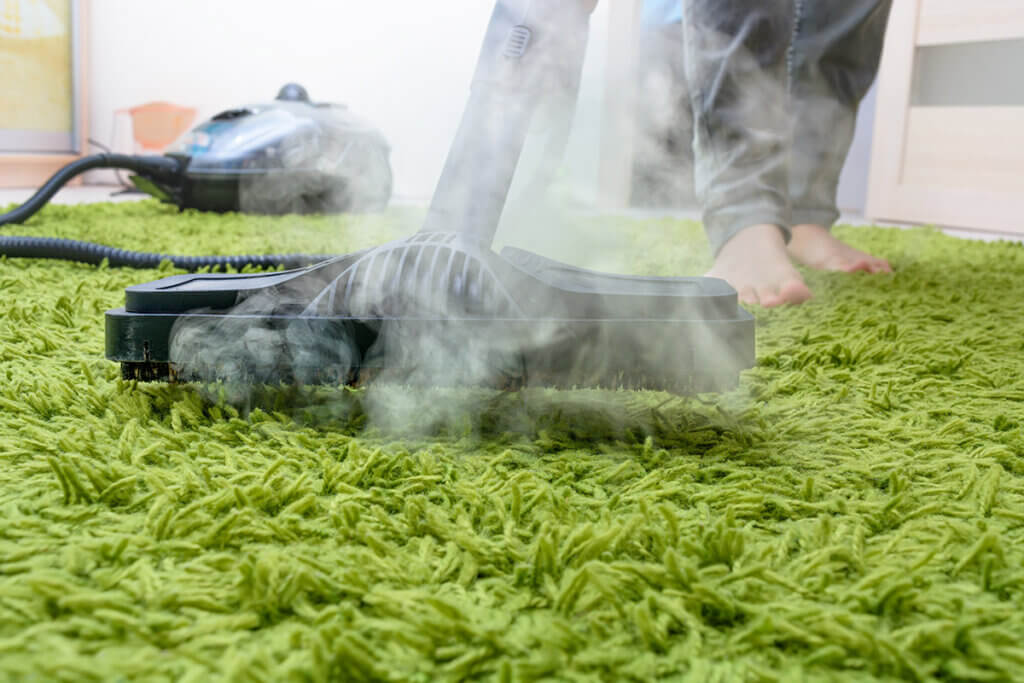
There are nozzles for different purposes, for example for hard floor or carpet cleaning. Operation is quite simple: simply move the tube or hose over the surfaces to be cleaned. The part with the canister simply rolls behind you like a vacuum. With many units, you can manually regulate the hot steam by pressing the handle on the cleaning unit.
Up top
Just as with steam vacuums, the hose on a steam cleaner means you can easily clean things high up, or even on your ceiling.
A characteristic feature of this type of steam cleaner is that you can cover large areas in a short time. The dirt is loosened from the floor by the steam and picked up by the cloth on the underside. You must clean the cloth after use. The easiest way to do this is in the washing machine. Many of the cleaning cloths can withstand washing temperatures of 140 °F (60 °C) or more.
The big advantage of this type of steam cleaner is that they have a very large water tank with a capacity of up to two quarts (2L). This allows you to clean large areas without having to refill the tank in between. The major disadvantage of this type of cleaner is its dimensions. They are quite big and bulky, which can make storage tricky. Additionally, they are quite heavy, weighing up to 22 lbs (10 kg) when full. However, while in use they are easy to move as they have wheels.
Advantages
- Quick cleaning of large areas
- Long working hours without refilling thanks to large water tank
- Manual steam control possible
Disadvantages
- A lot of storage space required
- Heavy
Steam mops
Steam mops, also called steam brooms, consist of a long stick with a handle. The water tank is located on or in the handle, which is rather small compared to larger steam cleaners or steam vacuums with a trailing canister. This is important as it ensures ease of use.
These models are designed for cleaning surfaces such as hard floors or carpets effectively and with as little effort as possible. They don’t need any extra attachments. Steam mops with a pointed floor nozzle make cleaning hard-to-reach nooks and crannies easy.
Compared to a traditional mop, the biggest advantage is that you don’t have to repeatedly dip the mop head in clean water, wring it out and then reattach it. This saves work and time. In addition, less force is needed to tackle dirt compared to traditional mopping. The hot steam loosens dirt without the need for scrubbing.
Models with an extra handheld cleaner
There are multitool versions that have an additional, handheld cleaner. This allows you to clean hard-to-reach areas.
The stick-shaped design of steam mops mean that they don’t require a lot of storage space. You can store them in a small storage room, in a household appliance cupboard or in an alcove. Some models can be folded or retracted for storage.
The disadvantage of steam mops, however, is that they don’t have a flexible hose, which makes cleaning high surfaces or faucets almost impossible. For your own safety, do not use steam mops above your head. There is a risk of scalding yourself if the hot water escapes from the tank. Steam cleaners with sticks are only suitable for cleaning floors.
Advantages
- Ideal for floor cleaning
- Simple operation
- Light
Disadvantages
- Only suitable for cleaning floors
Steam vacuum cleaners
Like steam cleaners, steam vacuums are similar in design to classic vacuum cleaners, but they do much more. Just like a vacuum, you pull the canister behind you. Unlike vaccum cleaners which have a dust bag, steam vacuum cleaners have a fresh water tank, heating unit, and a waste water tank.
Steam is released from the end of the hose or tube. Unlike steam cleaners, the loosened dirt is not absorbed by a mop head, but sucked back in by the device. As a result, you can use considerably more water or steam and the surface you are cleaning will stay dry.
This type of steam cleaner is best for thoroughly cleaning larger surfaces. Thanks to the additional suction function, surfaces don’t get as wet so can be stepped on again relatively shortly afterwards. In addition, sucking in the excess moisture prevents mold from forming on textile surfaces. Steam vacuums are therefore ideal for freshening up old sofas or carpets. The fact that there are no mop heads to absorb the dirt, saves effort, time and money.
A disadvantage is that steam vaccums are just as bulky and at least as heavy as steam cleaners. They are also expensive compared to other devices.
Advantages
- Suitable for cleaning large areas
- Best cleaning results
- Long working time thanks to large water tank
- No need to clean or replace mop heads
Disadvantages
- Expensive
- A lot of storage space required
- Heavy
Window steam cleaner
A lot of steam vacuum cleaners have a special nozzle designed for cleaning windows. For moderately dirty windows, this cleaning performance is usually sufficient. However, for extremely dirty windows, you might have to do some extra preparation beforehand, or give them a wipe down afterwards.
Better results with a separate window vacuum cleaner
The best way to clean windows is with specially designed window vacuums. These models are not steam cleaners. Before using one, you need to apply a mixture of water and a cleaning agent using a spray bottle and then rub it in with the cloth provided.
Next, you need to use the actual cleaning device to suck the loosened dirt and moisture off the windscreen. They don’t leave any streaks thanks to the rubber lip attached above the vacuum. These devices combine the functions of a wet vacuum cleaner and a squeegee. By the way, this works perfectly on mirrors too. You can also clean surfaces such as tiles in the shower or sealed wooden surfaces with a window vacuum. However, the results you get are often somewhat worse than on glass surfaces.
Handheld steam cleaners
Handheld steam cleaners are designed to be small, compact and operable with one hand.
They are ideal for cleaning small, hard-to-reach areas. They are especially good at removing dirt from gaps, faucets and household appliances.
Suitable accessories
With the appropriate nozzles and adapters, you can also clean windows, textiles and furniture with handheld steam cleaners.
Due to their compact design, handheld steam cleaners only have a small water boiler which produces a correspondingly small amount of steam. The flipside to this is that steam cleaners are quickly ready for use. This is a big advantage – the amount of steam they produce should be sufficient for small or medium-sized areas. Due to their low weight, they are suitable for small cleaning jobs around the home, in your garage, or in your car.
One disadvantage is that these small devices aren’t very powerful. Moreover, the smaller water tank means they can only work for 10 to 20 minutes before you have to refill them and wait for the fresh water to heat up.
Handheld steam cleaners rarely have a hose or pipe attachment so they aren’t great for cleaning floors. You would have to do the cleaning in small sections in a bent or kneeling position, which could lead to back problems, and would take a long time.
Advantages
- Quickly ready for use
- Light
- Flexible and mobile use
- Low purchase price
Disadvantages
- Usage time limited by water tank
- Not suitable for cleaning large areas
Combination units
Some steam cleaner models are multi-talented, and are great for a number of different cleaning tasks. In most cases, these are either steam mops with a removable handheld part, or steam vaccums with a range of different adapters. There are also attachments for handheld steam cleaners that make them better for cleaning surfaces. Please note that with handheld combination devices, the area they can cover in one session remains low due to their comparatively small water tank and boiler.
Other important criteria
In addition to the question of which style of appliance is best for your needs, there are a number of other factors that could influence your purchase decision. We have compiled the most important criteria for you.
Power (watts)
The power, expressed in watts, gives a first indication of how efficient or powerful a steam cleaner is when cleaning and disinfecting. Most models have an output of between 1,500 and 2,200 watts. However, higher wattage doesn’t automatically guarantee higher performance. Manufacturers are constantly innovating to reduce power consumption and thus operating costs. This means that short heat-up times and high temperatures can be achieved even with low-powered models.
Steam cleaners should have a power output of at least 1,500 watts. For efficient work, values around 2,000 watts are better. Due to the smaller water boiler, handheld steam cleaners manage with a lower output of around 1,000 watts.
Sometimes two different values are given for steam vacuums. One is heating power, which is usually about 1,000 watts, and the other is maximum power. The latter refers to the steam output and suction function – this can be more like 2,000 watts. Unfortunately, in some manufacturer specifications it is unclear which function the value refers to, which makes comparison difficult.
How high the power consumption ultimately is depends on how effectively the heating coil converts electrical energy into heat.
Power per unit area (square feet/meters)
You can compare the maximum area you can efficiently clean with one water filling by looking at the area output. In this way, you can distinguish whether, for example, you can clean a small bathroom or a large patio area with one tank filling.
Steam pressure (bar)
The values given steam pressure in bar need a bit of explanation, as it they can refer to two different things: working pressure and maximum pressure.
Working pressure
Working pressure is a crucial value. It indicates how high the pressure must be in the boiler before you can start working. As a rule, the higher this steam pressure, the more effective the dirt removal.
After the heating phase, the boiler switches off and you can start cleaning. While you are cleaning, water is taken out of the boiler, causing the working pressure to fall. If the working pressure falls below a certain level, the boiler is switched on again to replenish steam and thus keep the pressure in the boiler high during use. On units with a low working pressure, you may have to stop work until enough pressure is built up again. This can be very disruptive during larger cleaning projects. Models for home users usually have a steam pressure between two and six bars.
Maximum pressure
Maximum pressure is threshold which, if exceeded, automatically opens the safety valve to prevent the risk of overpressure. Some manufacturers state this maximum pressure in their product specs, which is often misinterpreted by prospective buyers as a higher working pressure.
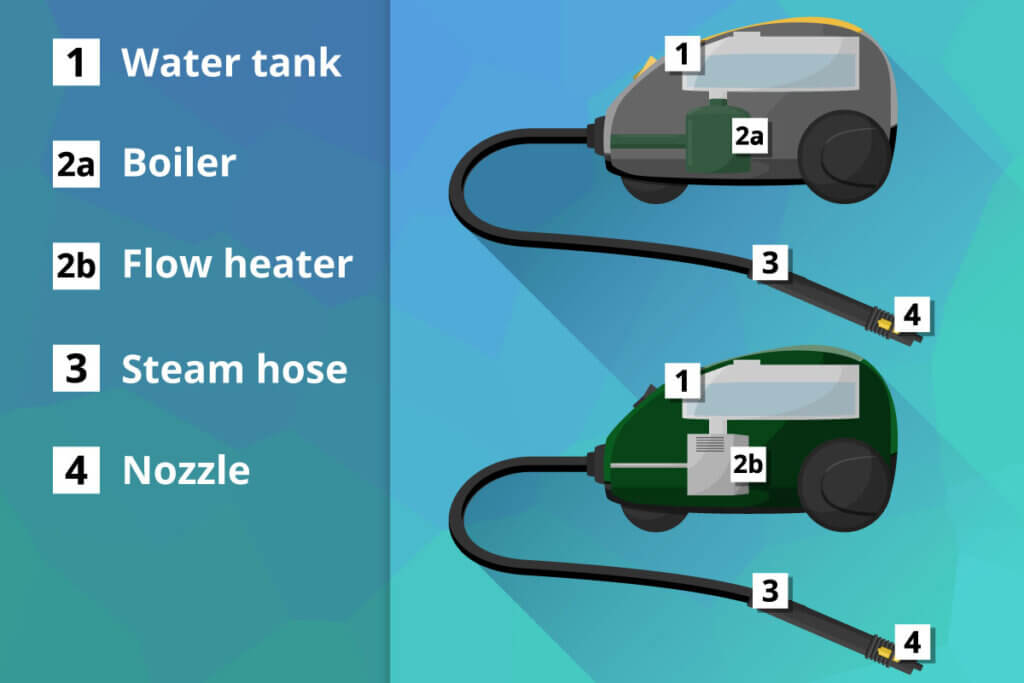
Steam pressure regulation (in steps or stepless)
This determines whether you have the possibility to adjust steam pressure via selector levers in steps or steplessly, and whether there is a constant delivery of steam as long as the appliance is switched on and the pressure is sufficient.
Maximum steam temperature
To achieve effective cleaning results, the unit should be able to build up steam which is at least 212 °F (100 °C). There are three types of steam which are generated at different temperatures:
- Wet steam: about 302 °F (150 °C)
- Dry steam: between 320 °F and 374 °F (160 °C and 190 °C)
- Superheated steam: above 572 °F (300 °C)
Not all manufacturers specify the steam temperatures of their appliances. Models for home use produce wet steam. Higher temperatures mean a higher risk of injury and are only reached by high-temperature models, which are mainly used in industrial settings.
Heating time (minutes)
Heating time indicates how long you have to wait after switching your steam cleaner on until sufficient pressure is built up and you can start cleaning. Some handheld steam cleaners reach working pressure after only 35 seconds, because the boiler only needs to heat up a small amount of water. Larger units need between four and six minutes for this, sometimes longer.
Models with larger tanks usually need a higher wattage because more energy is needed to heat a larger amount of water.
Water tank (size and type)
The size of the water tank also has a influence on the area you can work on and how long you can clean for before refilling. Small models have a tank volume of between 3.38 and 20.28 oz. (100 and 600 ml). Larger appliances with canisters, i.e. steam cleaners and steam vacuums, can hold up to 1.5 gallons (6L) of water. In private households, however, a tank volume of about a quart (1L) should be sufficient.
Pressure vessel with two-chamber system
A two-chamber system allows you to refill water during operation. If, on the other hand, your unit only has one water chamber, you need to wait for it to cool down before refilling it. If you’re planning on cleaning larger areas, such as a patio, look out for this feature when buying.
Flow heater
Some steam cleaner models are equipped with a flow heater instead of a steam boiler. These devices don’t heat the steam boiler and the water inside it, instead, they gradually evaporate smaller amounts of water. The liquid flows through a component such as a heating plate, which immediately causes evaporation. This steam that has just been generated exits directly at the nozzle. Steam is generated as needed. The absence of a boiler allows for a more compact design. This system allows for extended use with low energy consumption.
Power supply
Floor-standing units usually have a cable length of about 20 ft (6 m). This provides a lot of freedom of movement without having to move the cable to another socket. You can extend this further with an extension cable. However, make sure that the additional cable is suitable for the wattage of the steam cleaner.
Some models, especially handheld devices, have a rechargeable battery. This extends your range of movement, gives you more flexibility, and allows you to use the device in places where there is no power socket nearby, for example in your car or in your garden. With these cordless models, battery life is important. Once the battery is empty, you will have to recharge it.
Wireless models have a charging station where you recharge the battery. Some devices also need a wired power supply to build up the steam pressure. In other words, you need to plug them in before use to build up the steam pressure, but then afterwards you can unplug them for cleaning.
Safety
Since steam cleaners work with high pressures and high temperatures, safety is particularly important. Make sure that the appliance has a safety certification.
An important safety feature is a mechanism to prevent the boiler from opening until pressure has been fully released. This can be implemented by an electronic lock that makes it impossible to open it before it has cooled down. There are also some models that have a mechanism that has to be pressed down very hard, for example. This prevents it from being opened by children, or by carelesness.
Be sure to read the instructions carefully and before using the appliance for the first time in order to exclude potential application errors. For example, overhead use is not permitted with some appliances.
Helpful functions and features
In addition to the basic functions mentioned, there are other features that make some machines stand out from the crowd and make them suitable for special cleaning tasks. Read on for an overview.
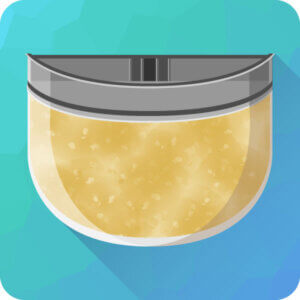
Limescale filter
With a limescale filter or a descaling cartridge, you can increase the lifetime of your steam cleaner. If you do not use a filter or do not change it regularly, limescale will build up in the appliance. This is especially true if you have hard water in your area. If this happens you need to clean the tanks and supply lines and treat them with a descaling agent before continuing work. It is always worthwhile to stock up on a replacement filter.
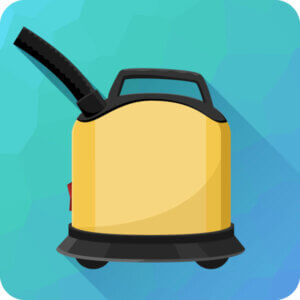
Disinfectant tank
If you want more cleaning power, you can get an additional disinfectant tank. These are suitable for particularly thorough cleaning of bathrooms, showers and toilets.

Dry steam
Dry steam is generally referred to when the steam temperature exceeds 338 °F (170 °C). It then contains virtually no more water droplets and therefore enables good, germ-free cleaning. Dry steam is also suitable for cleaning textile surfaces such as sofas and carpets without an additional extraction function.
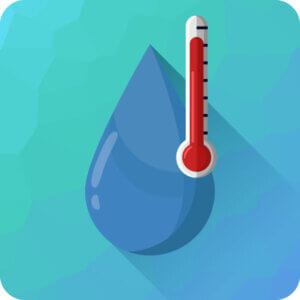
Hot water
In addition to steam, some models allow you to rinse things off with hot water. This saves a work step, as you do not have to sweep or wipe away loose dirt yourself.
Alternative distilled water
If you are considering whether it makes sense to operate a steam cleaner with distilled water, don’t. Level detection does not work with distilled water in appliances with boilers. In addition, distilled water extracts minerals from the boiler, which can damage it. You should use tap water or a mixture of tap and distilled water in equal parts. You should also change the limescale filter regularly.
Accessories
In order to purchase the most versatile appliance possible, you should make sure that accessories for different uses are included with the appliance or can be purchased separately. This way, your unit can be used in a range of different situations, making it a worthwhile investment in the future. Read on for a list of the important accessories and special features.
Standard floor nozzle
This tube attachment is very similar in appearance to the floor nozzle of a vacuum cleaner. Instead of sucking in dust, hot steam is ejected and loosens the dirt underneath the nozzle. Many models allow a fleece mop to be attached underneath. This absorbs the loosened dirt when wiping over the surface to be cleaned. Some floor nozzles are also equipped with bristles that loosen the moistened dirt by scrubbing.
Steam vacuum nozzle
The floor nozzle of a steam vacuum combines the standard floor nozzle of a steam cleaner with the suction function of a vacuum. Escaping steam loosens the dirt and, if necessary, can achieve even more efficient results by scrubbing. The dissolved dirt is then absorbed together with the moisture.
Floor steam nozzle
A floor steam nozzle is an additional adapter that is attached to the end of the tube instead of the standard floor nozzle. It has the same diameter as the tube and is best suited for small indoor areas, but also for dusting indoor plants. Make sure to keep enough distance so that the steam does not harm your plants. However, for large-scale soiling, you won’t do much good with this tool, which is designed for selective purposes.
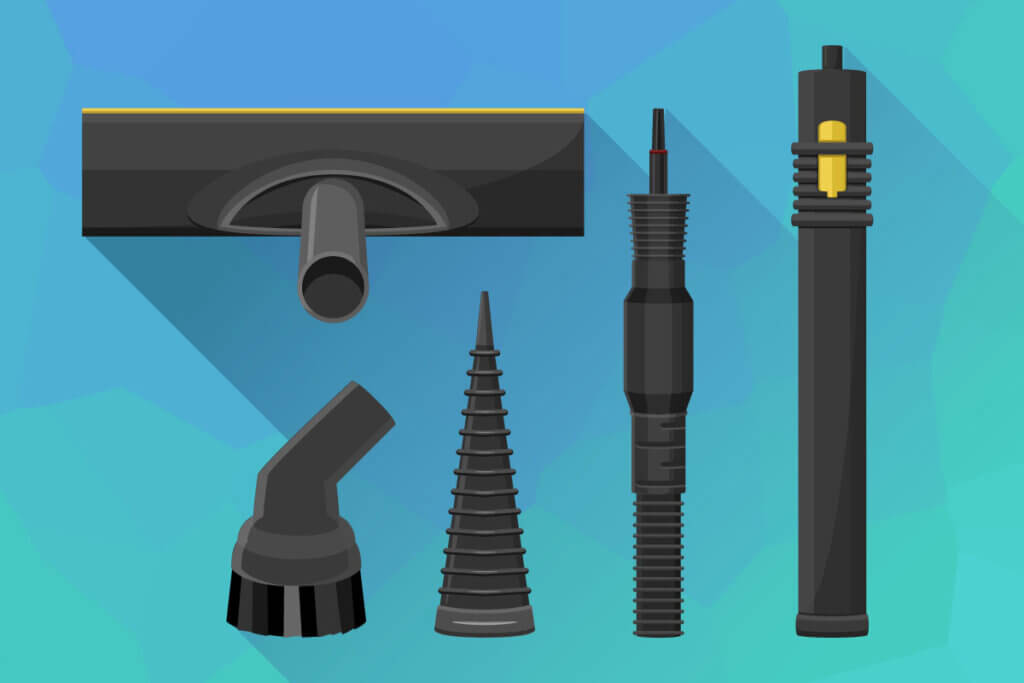
Round brush
Round brushes are very similar to floor steam nozzles, but they also have bristles on the underside. They can be used to effectively remove verdigris and other stubborn dirt from natural stone surfaces and tiles on patios.
Jet nozzle
Jet nozzles are one of the strongest weapons on a steam cleaner. Using a very narrow nozzle, you can apply steam at high speed directly to a surface, allowing you to reach and clean narrow and angled areas. For example, they are great for cleaning showers which have lots of joints and hard-to-clean angles.
Carpet gliders
Some manufacturers offer special carpet gliders for their floor nozzles. This allows you to freshen up your floor with the power of steam. They offer an extra advantage besides dirt removal: During treatment, carpet fibres straighten up which gives a coherent and tidy overall appearance.
Iron function
In some cases, steam cleaners come with a separate iron that you can use without an additional electrical power supply. For users who do a lot of ironing, this brings enormous advantages, as there is no need to constantly refill the small water tank of a conventional iron.
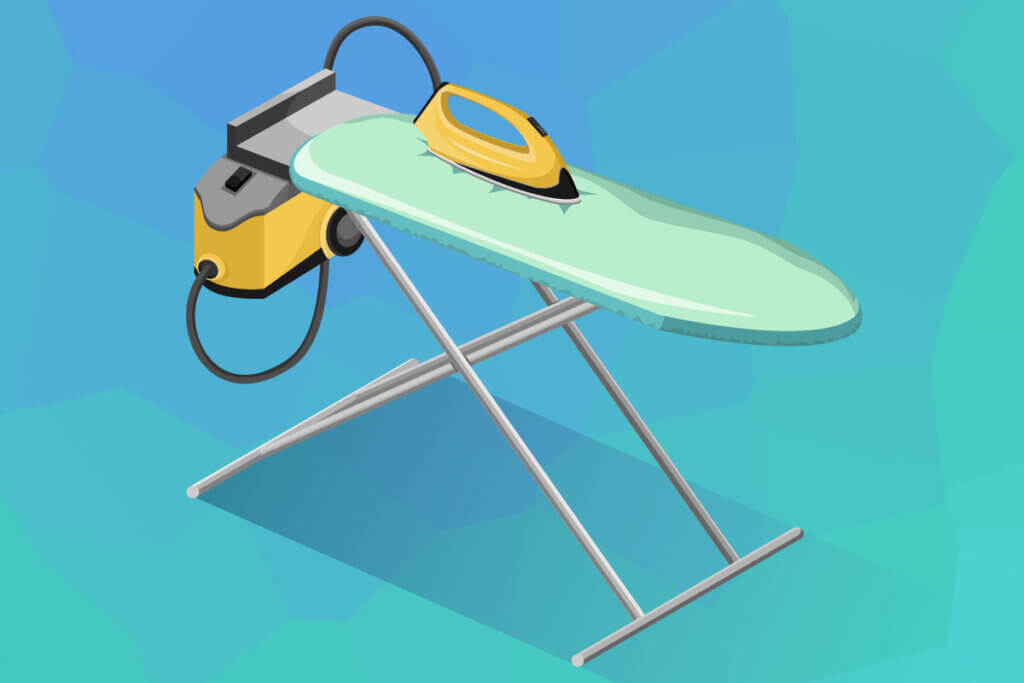
Cloth sets
Many manufacturers offer a range of different cloths, for example made of fleece, to be placed underneath the floor nozzles. In this way, dirt gets absorbed directly into the cloth. Thanks to sophisticated fastening methods, such as hook-and-loop fasteners, some models can be attached easily and the cloth can be changed without coming into contact with dirt.
Image 1: © penyushkin / stock.adobe.com | Image 2-8: © FinalCheck

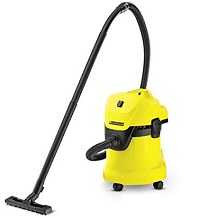
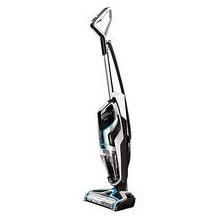
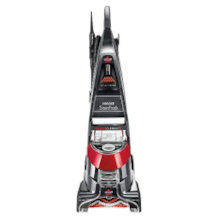
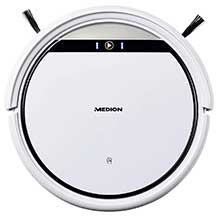
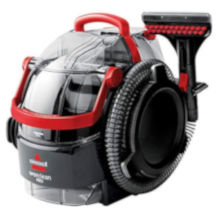
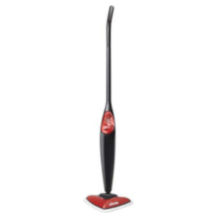
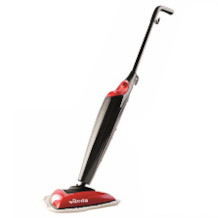

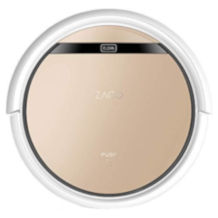
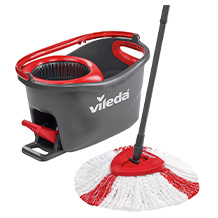

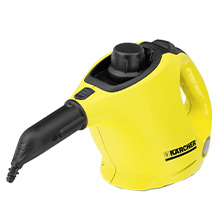
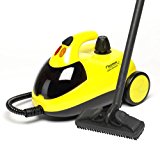
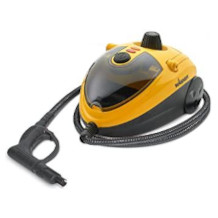
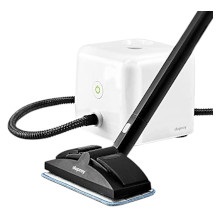
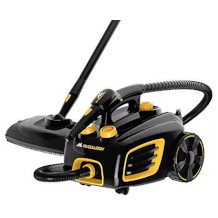
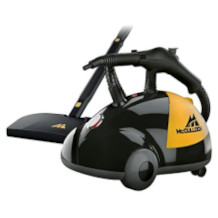
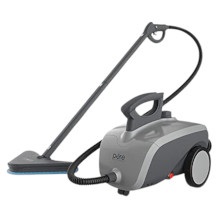
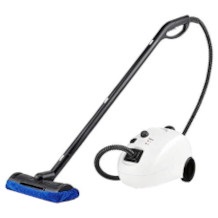
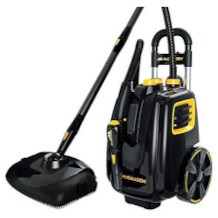
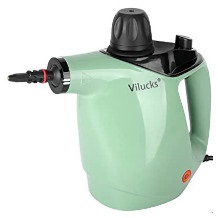
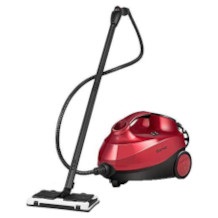

 5,568 reviews
5,568 reviews
